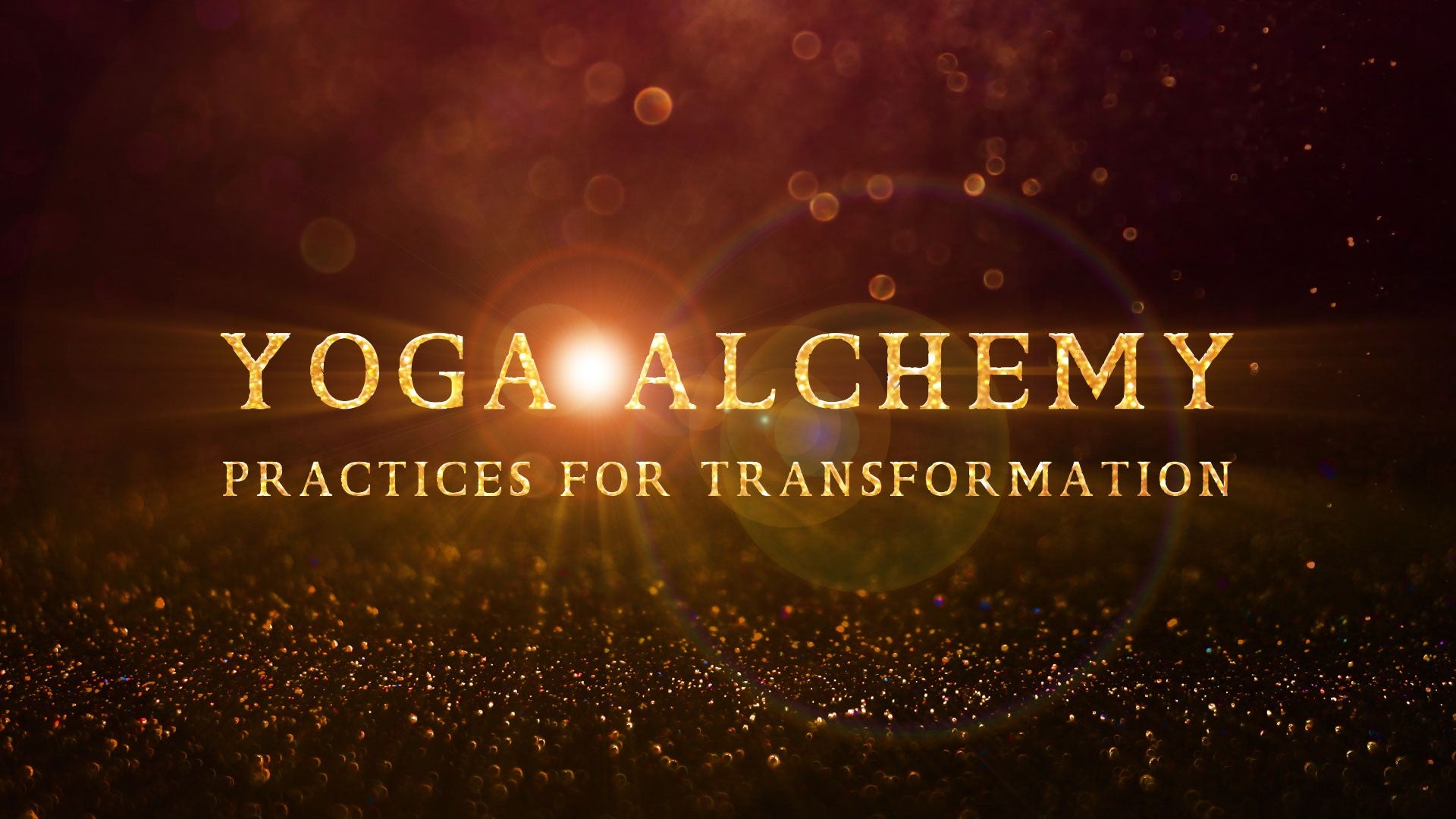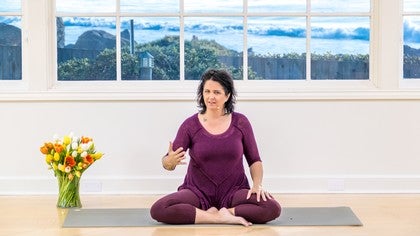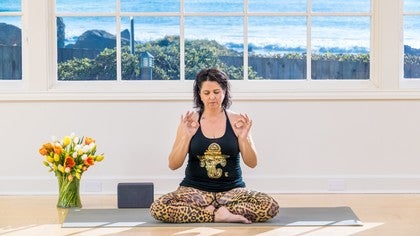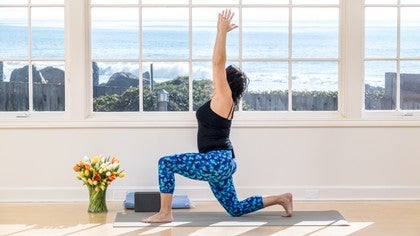Description
About This Video
Transcript
Read Full Transcript
Namaste. Today's class is about the sentient breath. So think about that word for a minute. It's what sentient means. It means a consciousness. I'm gonna do a little backstory, tell you a little bit about where this came from. So over the years of my practice, first few years of my practice, the breath wasn't talked about a lot, a beautiful teacher, and she was very wise to keep my mind focused on the alignment of my body. And when she finally did begin to introduce the idea of the breath, moving the breath with the body, it was so profound for me. I fell completely in love with them, adding that to my practice and feeling the combination of those two things. I really got into it. I was studying with a lot of teachers and I began to have this interaction with my breath where I wasn't really loving it so much anymore. I was trying to control it more and more. It was really missing the point of the pranayama in some ways. I was wanting to corral the breath, to control the breath, to align the breath. Over time it was sort of like I had this imaginary whip and I was like whipping my breath into the place it was supposed to be. All the while my teachers are saying, you've got to relax. You never find it unless you relax. You have to relax more. Relax the mind. Finally, I kind of just stopped. I was so at odds inside myself of hitting plateaus for so long that I just sort of backpedaled and decided to just go back to observing the breath. Just observing the breath. And one day what I observed was that my breath was alive. It was something really other than me. It was, it was, it had its own sort of personality. It had its own dialogue that it was trying to talk to me about, that I was having a hard time listening because my mind was so hardened around the idea of making it do things, making it be a certain way in the practice. I began to think of it as a friend. How would I treat a friend? How would I treat my friend, the breath? How will it feel when it comes into my body? Would it be like when my friends actually come to my house and I'm so excited and I fling the door open and I can't wait to have them come in? What if my breath could feel that way? And at the moment of that thought everything changed. This co-creative process of bringing this living organism of the breath into my body to nourish me, to wash me, to watch it leave and to feel that release. Like when my friends leave after the dinner party. It was so magical. And that's what I want to guide you in today. Just a little taste because it's something you can take in your meditation practice, into your pranayama practice for sure, into your asana practice, into your life yoga practice. So first thing I'd like for you to do is get your blanket, prop yourself up on your blanket so that you are high enough that your hip points are higher than your knees. This allows you to be comfortable. Sometimes this is even comfortable and you really need to actually lay down. But not lay down like shavasana, not lay down like nap time because we want the mind to be clear. In that case we're gonna take the blanket. It's at a low setting. It's nice and thin. It's just enough softness for the back of your head. It allows for a deeper relaxation. And you're gonna turn on your mat and lie down just like this. So the back of your head is supported by the blanket. Your legs are going to be bent. You can widen the feet and let the legs drop towards one another a little bit. This is very relaxing to the system. And rest your hands on your body. The connection of the hands will be important. If you're sitting, your hands are gonna be on your lap. So if you're lying down, your hands are gonna be here. This is your position. If you need to lie down for the pranayama, your eyes will be closed. And then we're going to observe the breath in this way. Now when you're done lying down, coming out is as important as being here. This is how I'd like you to come out. You're gonna roll onto your side. Keeping the eyes quiet. You can even be closed. And you roll a little towards your navel and bring yourself up nice and slow. Okay? So that's if you need to lie down. It's fine.
Now if you're sitting, it's gonna look like this. Aren't you excited? You're about to meet your friend. It's gonna be great. Your hands are gonna rest on your lap. It's like this. The body relaxes. The relaxation is so important. Right? When your good friend is coming, when you're gonna meet with your good friend, are you tense? No, you're not tense. You're like, you're so happy. You're so relaxed. This is what we're looking for. So go ahead and wiggle a little bit around on your blanket. Get nice and cozy. If you're lying down, kind of settle in. Kind of wiggle yourself into the floor. And then begin to grow still. Because at first, sometimes there's a shyness. Maybe you haven't really thought about the breath as anything more than something inorganic. Right? Or maybe you took the path that I did where you thought you had to sort of like be mean to it. I don't know. But initially, as we sit, we're just going to be still, relaxed, and wait. Now I find that it's helpful to close your eyes. And just as I said before during the series, sometimes the eyes don't want to close. And there's this flutter of the eyelids behind your eyes. And the eyes actually feel like they're pushing out. They're a little bit hard. If that's the case, the suggestion is to open your eyes. But gaze down at the floor and try not to focus on anything on the floor. In other words, you're activating the peripheral vision. So that from the peripheral vision, the eyes drop out. So beautiful, relaxed. Again, your hands are resting on your lap. Feeling quiet. You could even be leaning against the wall a little bit if you need to. First things first. From the stillness in your body. Feel the letting go of any tension. Your mind may be excited, and it may already be watching the breath, and that's fine. You're relaxed, and you begin to notice the air moving into your body. Superimpose that feeling of meeting your friend. This is life. This is life. And life is for you, always for you. And it's moving into you, and it's in a moment healing you, bathing you. We can go without food for some time. We can go without water for some time. We can't go without the breath for very long. The breathing is a co-creative experience. Your breath, your breath was your first lover. Your first intimate act was taking that breath at birth, letting life into your body. It is magical. It is the finest part of the alchemy. Undefinable. And the release of the breath is as beautiful. You're letting go and making room for more life. Now the initial interaction, if you're feeling it, is quite blissful.
Usually the mind starts to come in, and it dials up its volume a little bit. If that happens, as you're moving through this practice, simply turn your mind to counting. And just count, maybe from ten down to one, your breaths. Gives the mind a little something to do, and it allows you, your soul, that part of your mind that is a part of the soul, it allows that to interact with the breath. So begin now. Ten breaths. So life entering the body. The out-breath making more room. And as you finish, let the eyes softly open. Now one of the amazing things that happens with the out-breath, it's on the out-breath that the oxygen that's been brought in actually invest into the bloodstream. That's when it's moving deeper. Each exhalation moving deep, life is moving deeper into you. It feels like it's leaving. Making space for the next breath. But what's actually happening is that life-giving essence is investing into your system. It's brilliant. So the beauty of the inhalation is matched perfectly with the beauty of the exhalation. There's that alchemy again. So let's breathe one more time counting. Ten breaths from ten all the way down. Letting the mind's intention remember that the out-breath is as fundamental as the in-breath.
Falling in love. And as you finish with the tenth breath, again allow the eyes to open. And keeping the gaze soft, again activating the peripheral vision, feel what's taken place. Sometimes there are feelings that have no language, so just feel any differences that may be there. Now as I said before, you can use this anywhere, anytime in the postures, in the meditation, in the argument. It's a part of the yoga practice that is so intrinsic. And it was my great pleasure to share it with you. It's one of my greatest gifts that I've gotten from this practice over the years. Use it well. Namaste.
Yoga Alchemy
Comments
You need to be a subscriber to post a comment.
Please Log In or Create an Account to start your free trial.















